The world is on the edge of a new age, and Web3 is at the forefront of this change. The internet, as we know it, is ready for the era of decentralization.
Ownership, transparency, and permissionlessness stand as the three founding pillars on which Web3 is being built. However, a lot of marketing principles are still built out of Web2 strategies. What does the advent of Web3 mean for marketing?
Seeing as we’re all today-years old in the Web3 space, a clear definition of what it is still leaves even the best enthusiasts tongue-tied. However, through thorough research and an understanding of the intersection between Web3 and marketing, simplifying this phenomenon is exactly what we’ve done.
In this article, we’ll start by defining Web3 and its key elements, then we’ll work our way through to how it will impact marketing and why implementing a Web3 marketing strategy for your business can be a game changer.
What is Web3?

Like any good trilogy, you can’t start the third installment without seeing the first two. So let’s rewind. Here, we’re going to unpack Web1 and Web2 and examine their impact on technology and society.
Web 1.0
Web1.0 was the first internet. Its early development was attributed to renowned scientist Tim Berners-Lee in the early 1990s. It was considered a static web which means users could not send information to the internet but could only receive information provided by corporations.
Think of it like looking at a painting in the Louvre. No matter how much you like the Mona Lisa, looking at it is the only thing you’re allowed to do.
Web1 was a great feat in Information technology but it had its downsides. Being a static web, users found it hard to connect with. Web pages weren’t as dynamic as the ones we have today. They were simply pages hyperlinked together for human consumption.
Web 2.0
Fast forward to 2005, when Web2 caused a paradigm shift in how we use the internet. Web2 served as the flagship for 21st-century advancements, and it is categorized by user-generated content (UGC), user participation, and web applications.
Improvements in programming languages like Javascript, CSS, and HTML5 allowed for the rise of interactive and rich websites. This allowed users to send information to the internet, create their content, and inadvertently play active roles in the success of the centralized system.
Additionally, mobile applications also play a huge role in Web 2’s success. This is why it is referred to as the ‘social web.’ Platforms like Meta (formally Facebook), Google, Twitter, and YouTube, have all added to its proliferation and are able to see phenomenal revenue growth. These platforms have a great impact on society, from job creation to business marketing. The social web is why you’re able to connect with this post today.
Web2 simplified everything from how we order food, to how we listen to music. But it is not without its downsides. Web 2 allows massive centralized tech corporations that dominate the flow of information to tremendously capitalize on user data without the user having a piece of the pie they helped create. Now, this is where Web 3.0 comes in.
Web 3.0
Web 3 or Semantic web (coined by Tim Berners-Lee) is believed to be the ‘future of the internet’ and is the next stage of the internet’s evolution.
Here, the internet is completely decentralized, meaning it’ll be controlled by millions of devices linked together by one network. As opposed to one giant centralized server holding all the data.
To add, people will contribute to the content and the governance of this new internet. While it relies heavily on edge computing, blockchain technology, and machine learning as its primary layers.
Now, naturally, some may ask what is the point of Web3 when Web2 is already so beneficial to millions? The simple answer is ownership.
To elaborate, Web2 does not allow people to have true ownership or control over their own data. On the other hand, Web3 will allow people to own what they create on the internet in addition to owning their data. Thereby making it a read-write-create -own internet.
The decentralized internet might still be a few years too early however, it already has several networks that will serve as the pillars of exchange, entertainment, storage, and communication.
With Web2’s read, write and create internet drifting slowly into the sidelines, Web3’s advanced algorithm will attempt to interpret individual data and customize it for each user.
Prominent Features of Web 3.0
Web3 takes a 360-fold upgrade from its predecessor. Here’s why:
1. Semantic Web
A lot of content that is available on the web is fairly unstructured and designed solely for easy human consumption. This was the intention of Web2 and it was spot on.
Now, the new internet wishes to be more anticipatory to human needs.
The semantic web’s objective is to make web data easier for machine understanding with the aim of developing a more intelligent and connected web experience for users.
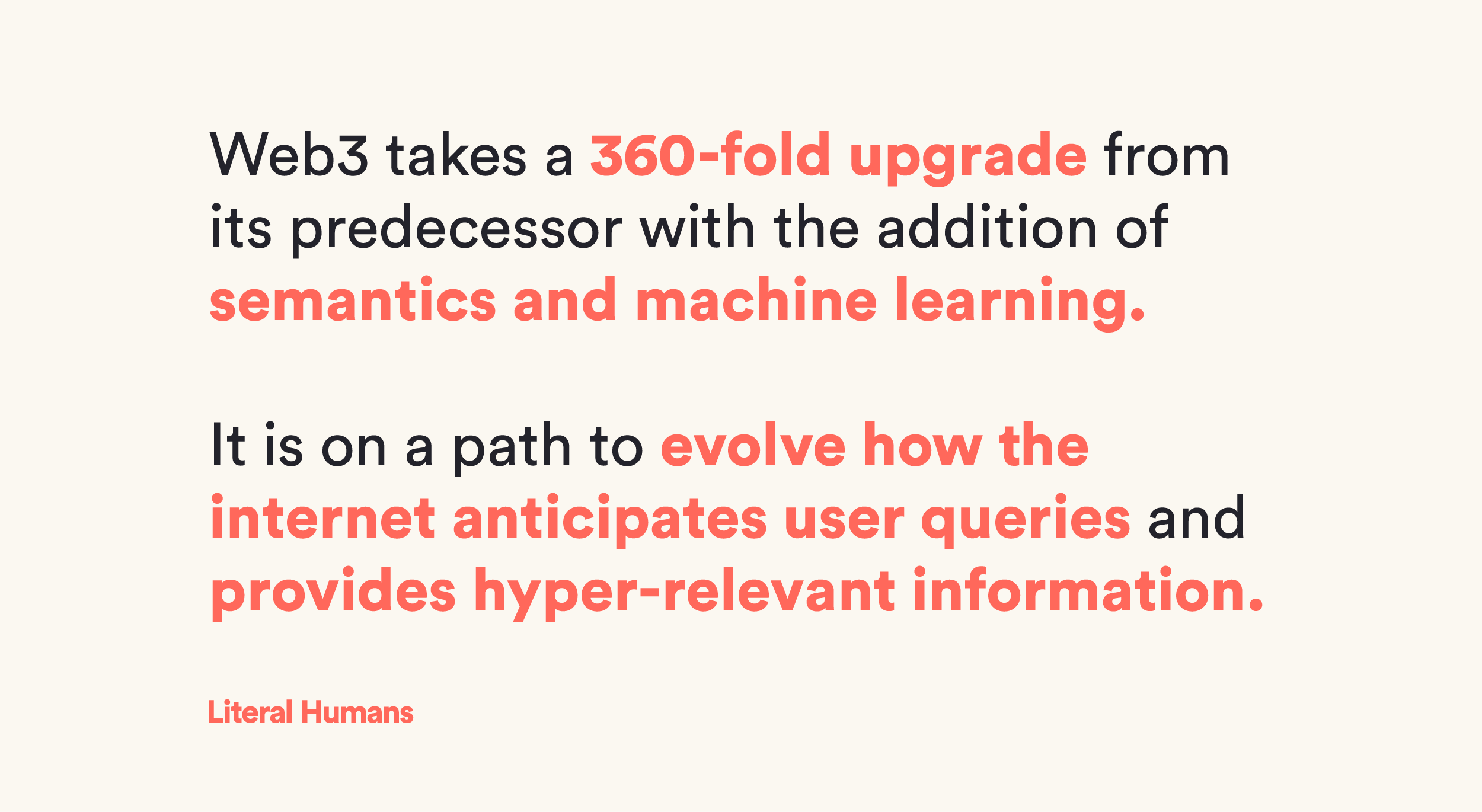
It plans to structure the web in ways that reveal more information, relevance, and relationship to the content itself, thereby making it easier for machines to process. Consider it as an expanded version of the existing World Wide Web.
2. Decentralization
Decentralization means that there is no central authority controlling the internet. Instead, it is a distributed network where each internet user is responsible for their own data and content.
In this burgeoning ecosystem, users will possess the knowledge and total control of where their data is and how it’s being used. And being open source, a decentralized internet would enable users to report problems, correct them and create tools that make the internet better for everyone.
3. Blockchain Technology
Blockchain is a distributed database that allows for secure, transparent, and immutable transactions. It is the backbone of decentralized infrastructures and will serve as the backbone of Web3 as well.
Besides transaction storage, the blockchain is also designed to combat data breaches. Historically, data breaches are a regular occurrence in Web2 applications—to the extent that we’ve created websites dedicated to keeping track of data breaches and informing you when your personal information has been hacked.
Until now. It has been a recurring problem as more and more internet users are realizing that many web 2.0 companies are storing their data for more data leads, without consent. These companies are guided by exploitation by any means but with Web3’s blockchain technology, data insecurity will be promptly curbed.
4. Improved Data Privacy and Security
Web3 makes it easier for each internet user to choose who can access their data and what they can do with it.
Naturally, individuals who sell their data in Web3 can profit from it instead of unconsciously delivering it freely to a centralized system when you “accept all cookies” on your Web2 websites.
Now that we’ve established exactly what Web3 is and its key features, we’ll proceed to explore how it affects marketing and the marketing industry.
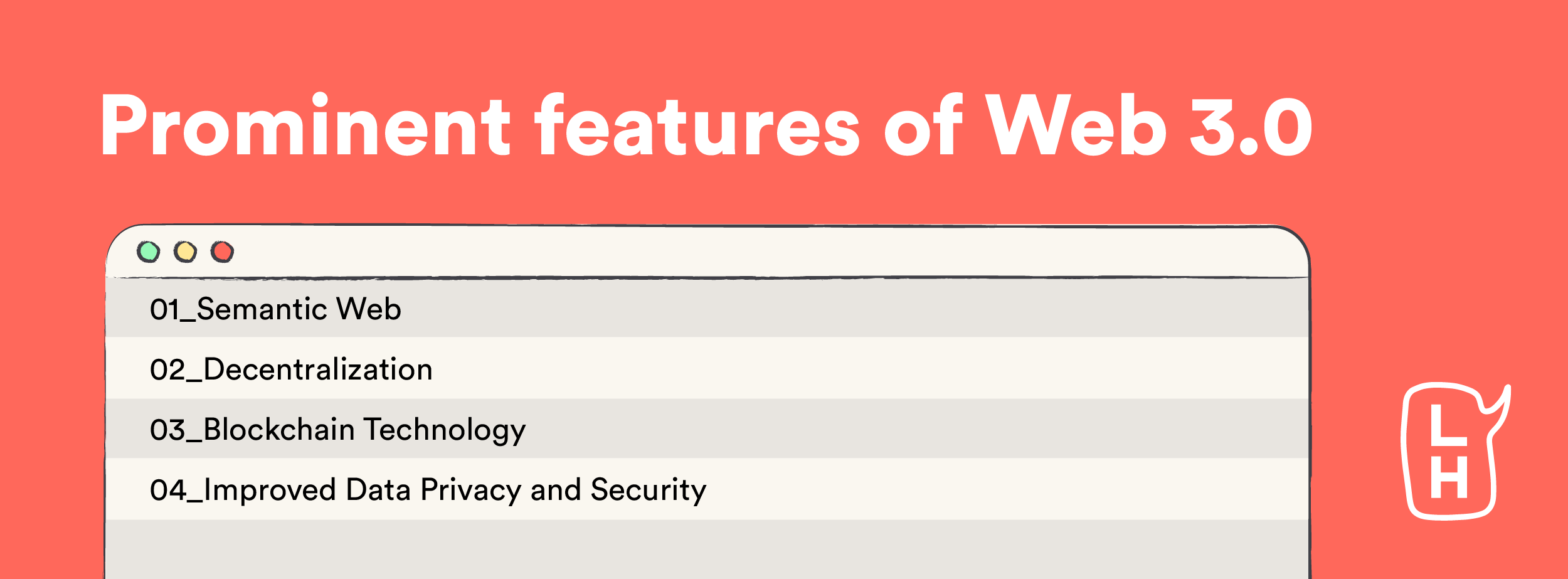
What is Web3 Marketing?
Marketing in Web3 will go beyond paid ads, emails, and search engine optimization(SEO). Instead, it’s going to upend the way we think about the Internet, how we create, and how we connect with our audience.
Web3 will amplify the marketing ecosystem and in order to survive in this evolving field, your strategies must evolve with it. Instead of abandoning the old ways completely, past strategies can be modified to fit the times.
Let’s look at what Web3 brings to the table from a marketing standpoint:
Web3’s impact on digital and content marketing
Traditionally, organizations have focused on a blend of advertising, public relations, and direct marketing to create awareness for their products and services. However, with the arrival of Web3, the digital landscape has completely shifted.
1. Changes to data collection and privacy
Since users will be more protective of their data, marketers will have to find new ways to gather information on their users. With third-party cookies soon eradicated from web and targeted ads made obsolete, collecting data and using online behavior will be arduous and almost impossible.
2 .Improved user experience
As user experience advances, marketers will be forced to think up new ways to reach their audience. The new internet will be personalized and tailored to the users’ preferences. What’s more, augmented reality/virtual reality will change how people interact and socialize with the online world.
3. The need to update marketing strategies
Web3 will bring new challenges and opportunities to marketing. To reach desired audiences, marketers will have to focus heavily on creating rich and relevant content, and developers will have to focus on creating problem-solving value-driven products.
Getting your Business Web3 Ready
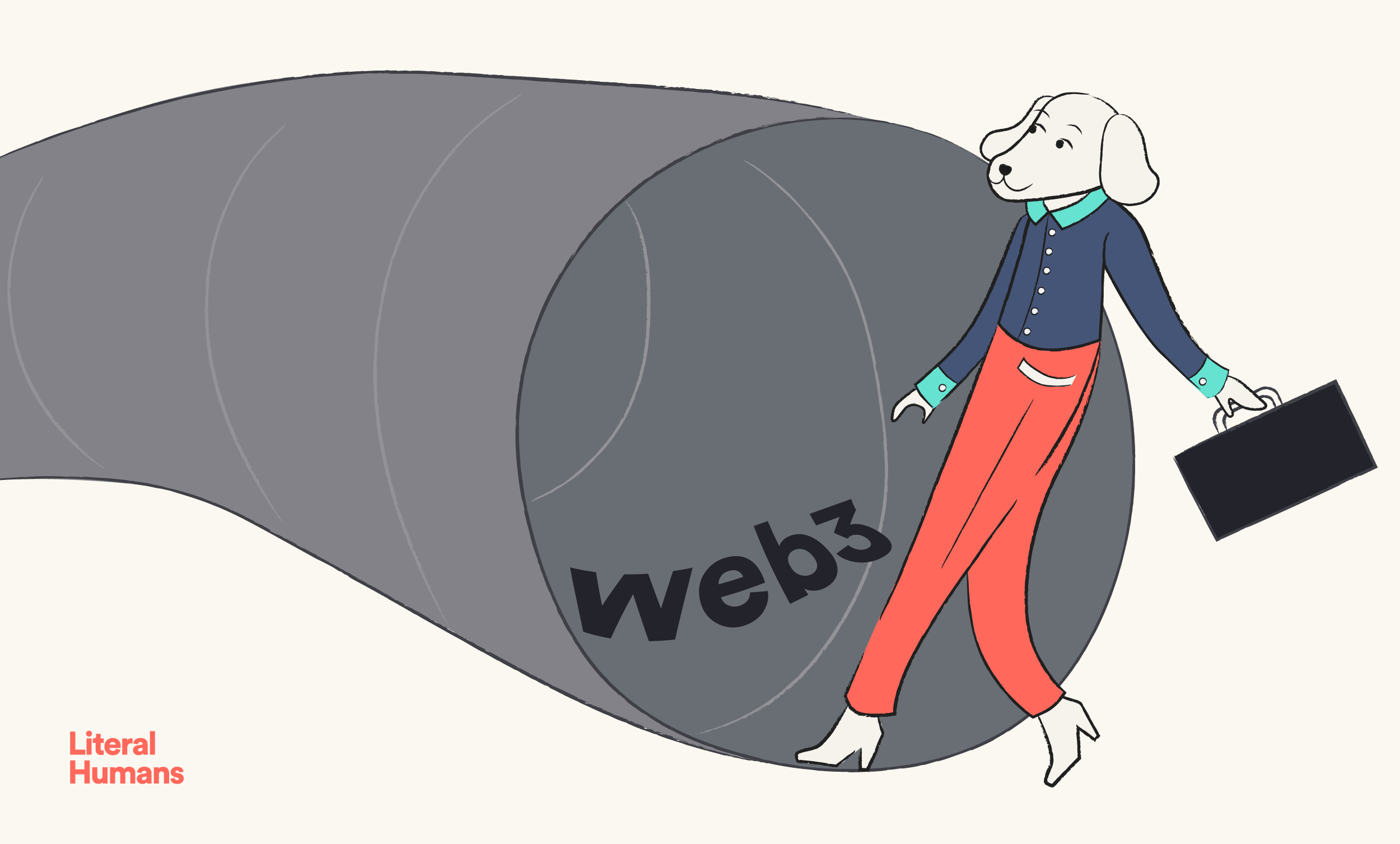
Web3 marketing can be a value-add for your company rather than a distraction. Entering the space hastily without a plan can cause irreparable damage to your brand. You don’t want your approach to come off as forced and unoriginal because your customers will definitely see it.
The space can be daunting, especially if your business is still struggling to keep its head on straight marketing-wise. So how do you get involved in a transformative space with Web3 without pulling your hair out?
Here are 3 ways (no pun intended):
1. Become risk-tolerant
Businesses are generally risk averse to Web3. That means that business owners during weekly round tables would say things like “let’s wait one more year” or “do we really need to have virtual land?” and my favorite “why would anyone want an overpriced jpeg?”
Although taking a risk can be, well, risky, you cannot deny the fact that Web3 is the inevitable trajectory of where the internet is headed. The risk here would be not taking any risk at all.
It is critical to start with what you already know coupled with a little research. For instance, business models can apply to Web3 as well. In business, old and new, taking care of your investors and customers with information like having pitch decks, roadmaps, and well-structured strategies is a huge “do” in this space.
2. Audit your business to find time and resources
The world is moving quickly, and businesses will need to work on the best timing for themselves with respect to resources, etc. Here, you will want to consider if it is the right time to migrate to Web3 by taking market appetite, investor focus, and industry knowledge into consideration. Be sure to ask “Is the market just right to jump in or is it not” and you answer them by keeping track with the latest news surrounding the industry.
Also, business owners will have to take an unbiased look into their finances. With the help of your financial manager, take a long hard look at the books to determine if you have the resources to acquire Web3 talent, build a blockchain-based product or feature and launch successfully without breaking the bank.
After all this has been sorted, the next step would be to start to building a Web3 strategy (you’ll learn how to do this in the next section).
3. Tell your story
Every business has a story to tell. So even if you struggle to find out what that is now, don’t sweat it. Big Brands and SMEs alike sometimes struggle to answer the question “what’s my story and how does it add value that’s compelling?”
Here’s how to do that.
Find a way to enter the Web3 space that is consistent with what you already do. Do what you currently do but use the space to expand on what you already do.
Find something you can do and talk about effortlessly. Instead of racking your brain about what you’re going to craft, think about what you already produce effortlessly that your customers relate with. If you can do it consistently, that’s your first win. Don’t overthink the content and make sure it’s in a format you’re already comfortable with.
As mentioned earlier, Web3 brings a lot of challenges as well as opportunities for marketers. Channels used with Web 2.0 like content marketing and SEO will remain but these have to be used alongside Web3 developments like NFTs, Metaverse, and tokens.
Let’s take a look at some ways you can stay ahead of the curve as a marketer in a Web3 world.
Web3 marketing strategies to get you started
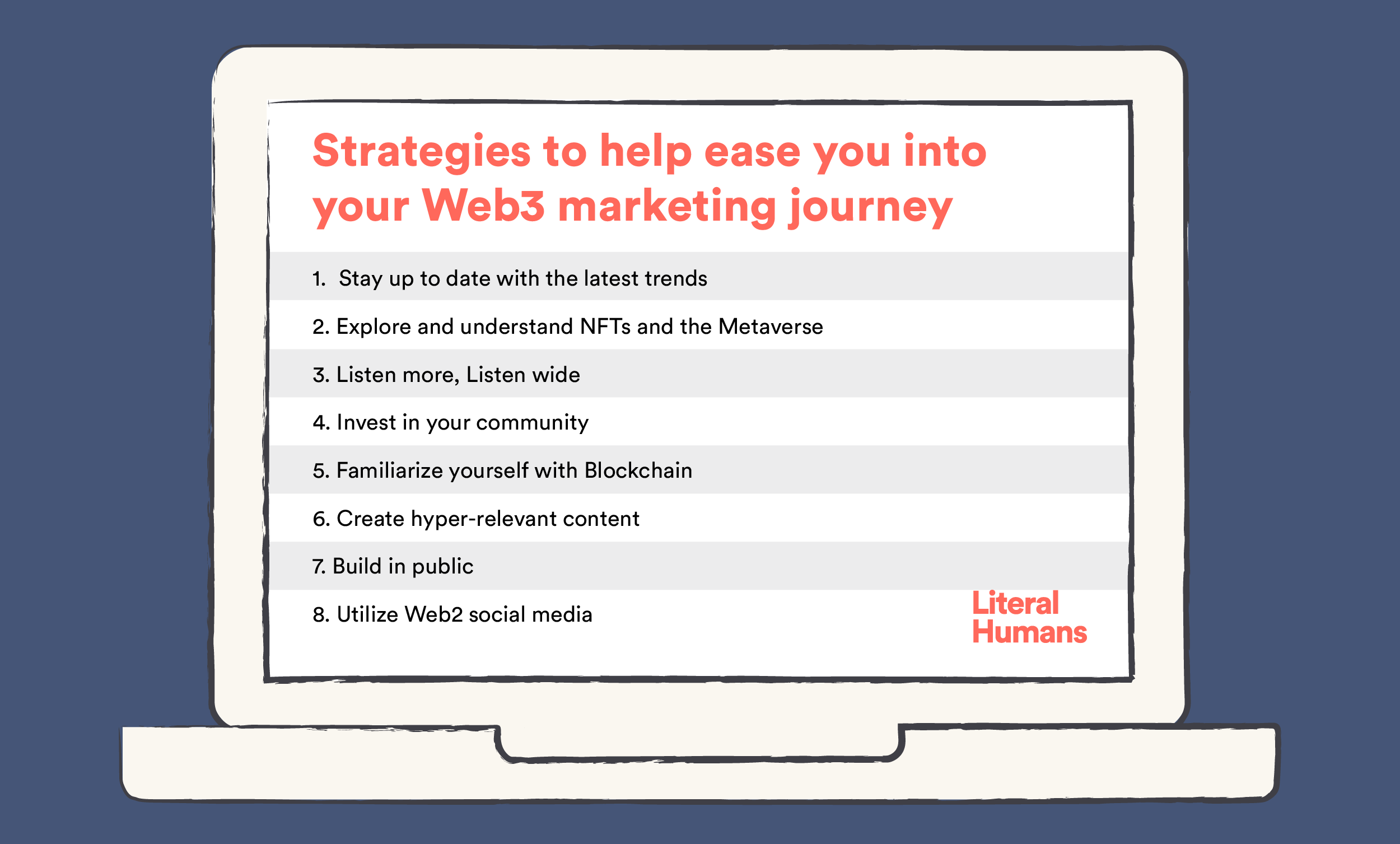
As humans, evolution is necessary for our survival but it also keeps things interesting. The following are interesting ways marketers can use their traditional marketing tactics and some new ones for Web3.
1. Stay up to date with the latest trends
As the concept of web3 is not fully formed, many blockchain-based companies will continue to pave the way with experimentation. Hence, keeping up with trends will keep you informed when breakthroughs are made.
Bear in mind that marketing for Web3 will utilize a hyper-targeted, rich, and interactive advertising approach and with the Web 3.0 movement still taking shape, it is critical to stay updated with trends in the industry.
Keep an eye out for these trends in the marketing style of blockchain-based businesses and start incorporating them into your marketing strategy. The more you know about the latest Web 3.0 trends, the more you’ll discover ways to merge them into your current strategies.
2. Explore and Understand NFTs and the Metaverse
In short, Non Fungible tokens (NFTs) are invaluable digital assets that are backed by blockchain meaning they can’t be forged, replaced, or converted and are safe from hacks, theft or any forms of manipulation.
Metaverse is a term used to describe a combination of virtual reality and mixed reality worlds accessed through a browser or headset, which allows people to have real-time interactions and experiences across distance.
The pandemic showed us how essential socializing is for everyone. The goal of the Metaverse is to expose the world to a new way of interacting that is fun and lucrative simultaneously.
Additionally, NFTs are not just overpriced jpegs unlike popular opinion, they have an array of use cases that can translate to any business.
3. Listen more, listen wide
Traditionally, brands mostly care about what they should be putting out, when to publish, and why. Unfortunately for web3, that won’t cut it. As stated earlier, Web3 is still in its formative stage so it is imperative that you listen first.
Listen to what the customers are saying, follow the conversation on Twitter, Reddit, Discord, and Telegram, and as you continue to absorb messaging, you’ll eventually get what you need (for that moment at least).
The listening never stops. In order for you to have contextual relevance to space, first, be part of the conversation by listening.
4. Invest in your community
Spending significant time and resources reaching, gathering, and shaping your community in Web3 will open up your business to massive upside long-term.
Companies miss their mark when they don’t invest in their community. Because data is going to be gated in the decentralized web, companies need to learn and find ways to invest, nurture and communicate with their community if they wish to acquire their target audiences’ data.
Some NFT projects tend to abandon their community when they’re successfully minted, leaving them high and dry. Forgetting that your community’s active involvement in your project determines the value of the project short and long term.
Best to come to your community with added value more than they expect. When you surprise and delight them, they, in turn, become incredibly loyal. Marketers will be forced to make meaningful relationships with customers and create partnerships that benefit everyone involved.
5. Familiarize yourself with the blockchain
Because Blockchain is a key feature of Web3.0, it is imperative that you learn about it. Understanding its possibilities will help you utilize it to your advantage.
Blockchain is a pillar of the decentralized web, especially in the financial aspect. So having significant knowledge about it is the way to go.
6. Create hyper-relevant content
Content is king everywhere, even in Web3. Web2 was the era of relevant targeted content. But it seems Web3 will be as well.
Blockchain-based businesses make use of relevant consistent content to attract their audience. Using the content principles of education, entertainment, and inspiration, coupled with a useful or valuable product, is bound to get your business moving in the right direction.
There are no concrete guides or handbooks for this new era of marketing, but we know that creating content relevant to notable features such as NFTs and the Metaverse is the right approach.
7. Build in public
As stated in the opening section, transparency is a founding pillar of Web3 technology. Our research has found that this cuts across blockchain-based businesses as well.
For instance, Eric Siu, notable crypto and web3 enthusiast, businessman, and YouTuber while building his Leveling Up Heroes NFT project would tweet “Building in Public, day one” and proceed to show/tell us what transpired that day in his journey. This continued from its ideation up until its launch (which was very successful).
Until now, centralized businesses create projects in the shadows, and only when it is complete do they let the public know. Transparency builds trust and trust gets you a community.
8. Utilize Web2 Social Media
Facebook, YouTube, and Twitter are still quite relevant at this early stage for Web 3 marketing. We’ve seen crypto-based projects build a strong community from these channels so when the full transition is required, they will maintain and advertise to their massive community.
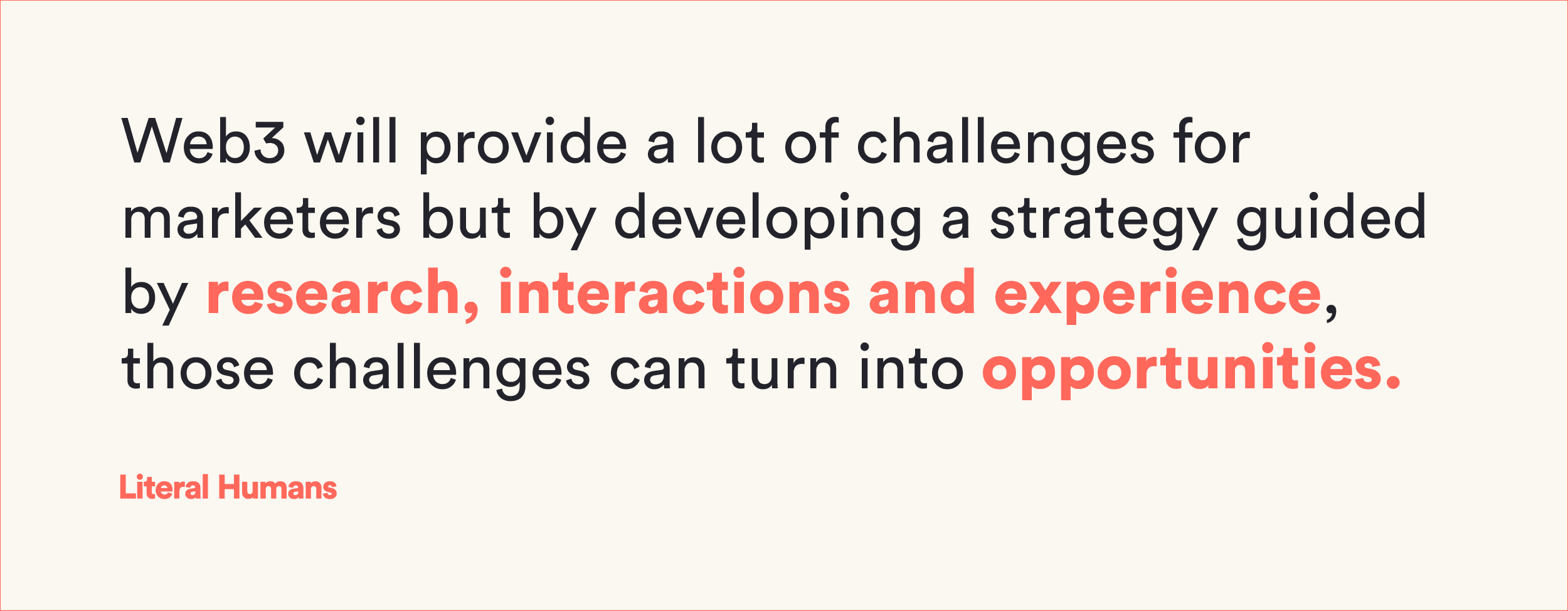
Web3, still in its infancy, will challenge marketers and businesses who wish to make this daunting transition. However, if done right, these challenges will provide new opportunities to acquire and retain customers. Because the companies that do their best at facilitating real human connections are going to thrive because human-to-human connection is the real focal point of marketing in Web3.
Starting out can be tricky, so aligning your business with a digital marketing agency can give you an experienced and realistic view on how to move forward in the decentralized marketing world.
Sign up for a strategy session today and get everything you need to make that big leap for your business!









